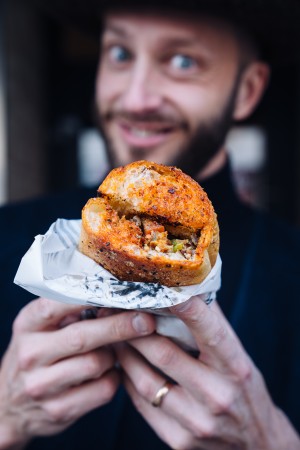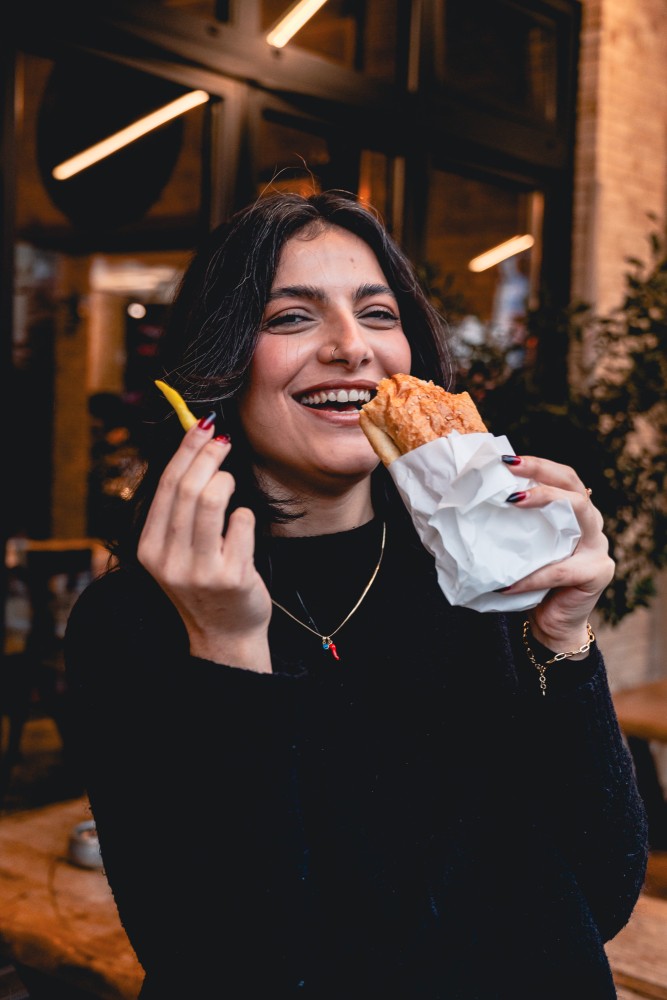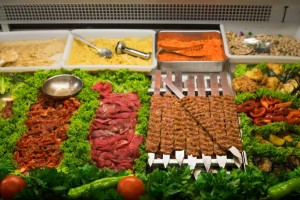What the döner is to Berlin, the kokoreç sandwich is to Istanbul and Izmir. In the words of Dilan Balku, aka Instagrammer and BFS Contributor, @dilaneatsfood: “If you’re having a drunken night out in Turkey, there always comes a point where someone asks, ‘Should we get kokoreç?’ And everyone else will immediately be like, ‘Yeah!’”
Kokoreç step by step, turn by turn;
Take the large intestine of a lamb. Thread it onto a turning spit with lamb fat and thymus glands, euphemistically referred to in English as “sweetbreads”. Wrap that many, many times over with the lamb’s small intestines, such that it resembles an elongated rubber band ball, and grill the whole thing horizontally till it’s golden-brown and glistening. Chop up the roasted offal and stuff it in a soft white roll, either by itself (“Izmir-style”) or further griddled with tomatoes and peppers (“Istanbul-style”). Alternate bites of that with pickled peppers; repeat till satiated.
Drunk or sober, it’s one hell of a sandwich, no Salat or Soße necessary. It’s komplett in its own right.
“ I thought it was banned in the EU... I mean, there was a whole song about it!
The dish has its roots in the Byzantine Empire and boasts variations in Greece and the Balkans. It’s been ubiquitous in Turkey since the 1980s, when savvy entrepreneurs realized the spit-wrapping could be done by industrial wholesalers instead of master craftsmen. Yet until very recently, it was nowhere to be found in Berlin.
Balku, who’s been following the restaurant scene since moving here from Istanbul in 2018, was overjoyed to see kokoreç make its long-overdue debut in Kreuzberg last summer. She was also a little confused.
“I thought it was banned in the EU,” she says.
“I mean, there was a whole song about it!”
The offal truth
Flash back to the turn of the millennium. Turkey was about to begin negotiations to enter the European Union. At the same time, new outbreaks of bovine spongiform encephalopathy (better known as “mad cow disease”) prompted the EU to introduce new, stricter slaughterhouse hygiene measures. Cow brains, intestines and a number of other organs were to be removed from the food chain and incinerated. Rumors spread that soon, sheep innards would meet the same fate.
For EU opponents, the narrative was irresistible: join the Union, say goodbye to kokoreç. The humble street sandwich became weaponized by Turkish media, symbolic of a national identity perceived to be under threat, pulled towards the Eurozone. Whether you were for or against membership, you couldn’t ignore the headlines. Or the 2001 earworm “Kokoreç” by pop star Mirkelam, with lines like “Your taste still on my lips/Let’s get together and defy the strangers who come between us.”
“ Join the Union, say goodbye to kokoreç
The truth is that lamb intestines have always been legal and in the food supply chain throughout Europe. Though BSE caused a scare, it didn’t impact the availability of Spanish zarajos, Italian torcinelli or even the near-identical Greek dish kokoretsi. But the gastro-nationalistic debate created enough uncertainty among Turks that, to this day, many still believe selling kokoreç in the EU is strictly forbidden.
That’s one reason why barely anybody has done it until now, another being that the process is a huge pain in the, well, bowels.
Gutsy pioneers
Here’s the thing. While kokoreç itself is legal in Europe, importing kokoreç spits from the motherland is not. The EU accepts barely any meat from Turkey – let alone offal, which since the BSE scare has been subject to stringent hygiene requirements.
That means anyone looking to sell kokoreç west of the Bosphorus has got to make it themselves, or find a European producer who can. And until recently, that just didn’t make financial sense. To get lamb intestines clean enough to eat, you’ve got to soak them, scour them and soak them again; stacking a döner spit is child’s play by comparison. “You need lots of water, power, space and workers,” says Stuttgart-based entrepreneur Canan Lalesoy of the procedure. “It’s not cheap. Especially in Germany.”
It was 2016 when Canan and her husband Murat, a chef who'd learned the art of kokoreç in his native Maraş, decided to introduce the delicacy to the Deutschen. “We wanted to show them that there was more to Turkish food than döner, but we always thought you couldn’t make it here. And then we sat down and worked on a plan.”
Two paperwork-filled years later, Lalesoy Kokoreç was up and running. A production facility in Stuttgart shipped out frozen, pre-wound spits to mobile franchises across the country, one of which opened behind the Kottbusser Tor station in May 2022. Finally, Berlin had a kokoreç stand to call its own.

That summer, the courtyard housing the Lalesoy truck was packed nightly with Turkish customers, only a few of whom balked at paying €8 for an Istanbul- or Izmir-style sandwich. Over time, they were joined by curious Germans and other non-Turks. “The feedback was Klasse,” recalls Canan fondly. But weatherproofing the outdoor space didn’t work out due to, yes, more bureaucracy, and they were forced to close – first for the winter, then indefinitely as the decision was made to open a more permanent spot.
Kreuzberg’s kokoreç mile
In the meantime, other restaurateurs began catching on. Around the beginning of 2023, two more kokoreç vendors appeared in the German capital – coincidentally located within a scant 700 meters of each other on Kottbusser Damm.
“ Gokoreç is a consumer-facing branch of a wholesale operation
Gokoreç, like Lalesoy, is a consumer-facing branch of a wholesale operation, in this case a Bulgaria-based outfit by the name of Mr. Koko. The lamb intestine spits are assembled at a facility in Varna and shipped off to franchisees, who serve them along with whatever other menu specialties they see fit.

While Mr. Koko’s website expresses ambitions to open a shop in every country in Europe, they currently maintain a presence in only Plovdiv, London, and Kreuzberg. “They tried it in Hamburg last year, but that one had to close because they weren’t cooking it well enough,” explains Haydar Bahçeci, one of a trio of brothers who manage Gokoreç Berlin. Therein lies another of kokoreç’s many complications – once you’ve got your spit, you can’t just shove it on a grill and hope for the best. It takes an entire day’s worth of careful roasting, split between a blast of high heat close to the coals and a lengthy rest higher up.
The Bahçeci brothers have mastered the art, be it for traditional Istanbul and Izmir sandwiches or the must-try Atom Kokoreç, a recently invented style that’s all the rage back home. Turkish vendors use “Atom” as a designation for any over-the-top food or drink, but the near-spherical constructions, consisting of fleshy, cumin-spiced sweetbreads wrapped in a thin, crisped-up layer of guts, do vaguely resemble the Rutherford model.

The rest of the menu is a panoply of lamby delights. Aside from kokoreç, Mr. Koko supplies the restaurant with two other ovine (lamb) offal specialties: mumbar, a type of sausage made from the large intestine; and şırdan, the stuffed and simmered stomach. There’s also trotter soup, miniature lahmacun, and – the owners’ pride and joy – cağ kebab, a horizontal spit of shoulder and belly meat and fat that’s stacked in-house and grilled over a live wood fire till succulent and smoky.
A drunk food paradise

You won’t find cağ kebab at M47, the street food spinoff of Hermannplatz grillhouse Mardin. But, you will find mussels. Lots and lots of mussels.
Popularized in the 1960s by immigrants from the Mardin province, midye dolma – mussels stuffed with spiced rice – are as satisfying a drunk snack as kokoreç, and as ubiquitous a sight in Turkish coastal cities. In fact, says M47 co-owner Battal Çiçek, it’s extremely common for the two to be sold side by side.
“ When the Russian invasion forced him out in 2022, Çiçek fled to Berlin and returned to his gastronomic roots.

That’s the case at the restaurant his cousin owns in Istanbul, where he worked as a teenager before moving to Ukraine to study medicine. When the Russian invasion forced him out in 2022, Çiçek fled to Berlin and returned to his gastronomic roots. He partnered with Mardin to set up shop right next to the three-year-old main restaurant, already a fixture in the Turkish community for its mammoth kebab platters, oven-fresh lahmaçun and foamy mugs of homemade ayran.
The stuffed mussels came first, arranged in eye-catching displays atop bright yellow barrels and offered like candy to curious passersby. Next, it was kokoreç’s time to shine. Though Çiçek had learned the procedure from scratch at his cousin’s place, he knew that logistically, the only way to sell the dish was to find a wholesaler. He turned to Usta Kokoreç, a Belgium-based manufacturer that began delivering spits to outlets around Europe in 2020 to serve as his supplier.
At M47, Usta’s raw product is expertly grilled and turned into sandwiches that are heftier (and commensurately pricier) than their counterparts at Gokoreç. The Belgians also supply him with şırdan, while a halal butcher up the street contributes regional German lamb for homemade mumbar as well as kuzu kelle: the animal’s entire head, roasted and eaten brains-and-all.
Thanks, Erdoğan
Gokoreç and M47 – and Mardin, for that matter – cater to a growing demographic in the German capital. Berlin’s Turkish population still primarily consists of former “guest workers” from the 1960s-70s and their descendents, many of whom have roots in rural Anatolia and whose views skew religious and conservative. However, in recent years, they’ve been joined by a new wave of young, urban arrivals fleeing their home country’s increasingly repressive climate. Unlike their predecessors, these Turks drink. And then they get hungry.
“ I’m constantly seeing friends from Turkey finding a job and moving here because they don’t see hope for improvement.
Among them are Balku, who says the political chaos of the Erdoğan regime strongly influenced her decision to come here to study. “A lot of educated and secular people from my generation have moved to the EU in the last 10 years,” points out the 29-year-old. “And it hasn’t stopped yet. I’m constantly seeing friends from Turkey finding a job and moving here because they don’t see hope for improvement.”
Just because they’re sick of the Turkish government doesn’t mean they’re sick of Turkish cuisine. “When I was younger, I used to make fun of dishes like kokoreç because they weren’t ‘European’ enough and thus not cool,” Balku says. “But once I’d lived abroad for a while, I started seeing the beauty of our culture and food. I missed having raki and meze while listening to Turkish music, eating midye dolma while drinking beer on a summer day… or ending a night with kokoreç. I wanted to eat food that wasn’t adjusted to the Western palate and standard döner shops didn’t satisfy my needs.”
“ I wanted to eat food that wasn’t adjusted to the Western palate and standard döner shops didn’t satisfy my needs.”
Here we have the last piece of the kokoreç puzzle. Because of the colossal investment of money, labor and time required to make the dish, nobody was going to bring it to Germany until it had a guaranteed target market. Now, thanks in part to the same nationalist sentiments that spurred doubt about its EU legality two decades ago, it does. The poetic justice is as delicious as a piping-hot intestine sandwich served at 2am (the latest M47 stays open).
And now that the dish is here, it's not going anywhere. In fact, since research began on this article, Sampiyon Kokoreç – a well-known Turkish chain with 52 outposts from Istanbul to Gaziantep – began selling its exceptionally moist, mild-tasting version of the dish in Charlottenburg. It's actually the franchise's second attempt to expand to Berlin, after a supply chain mishap prematurely shuttered their planned Imbiss on Kottbusser Damm back in 2015. Today, a partnership with a Bulgarian producer keeps the spits coming.
"We get older Turkish people who are in tears to see a kokoreç place, and younger Turkish-Germans rediscovering their heritage," says partner Anatol Hanau. The German-Germans, meanwhile, stick to the yaprak döner, named by BFS as one of the best in the West. "We're still seeing what flies here," Hanau tells us, but once the concept has solidified, branches in the Netherlands, Belgium and, yes, Kreuzberg won't be far behind.
From illicit drunk snack to continent-wide domination: the day may well come when the kokoreç sandwhich is as ubiquitous as the döner kebab in Berlin. Canan Lalesoy certainly thinks so. "It's exactly like when döner entered the market here. Somebody had to do it first, but once they did, it was everywhere. We’re just the beginning.”









